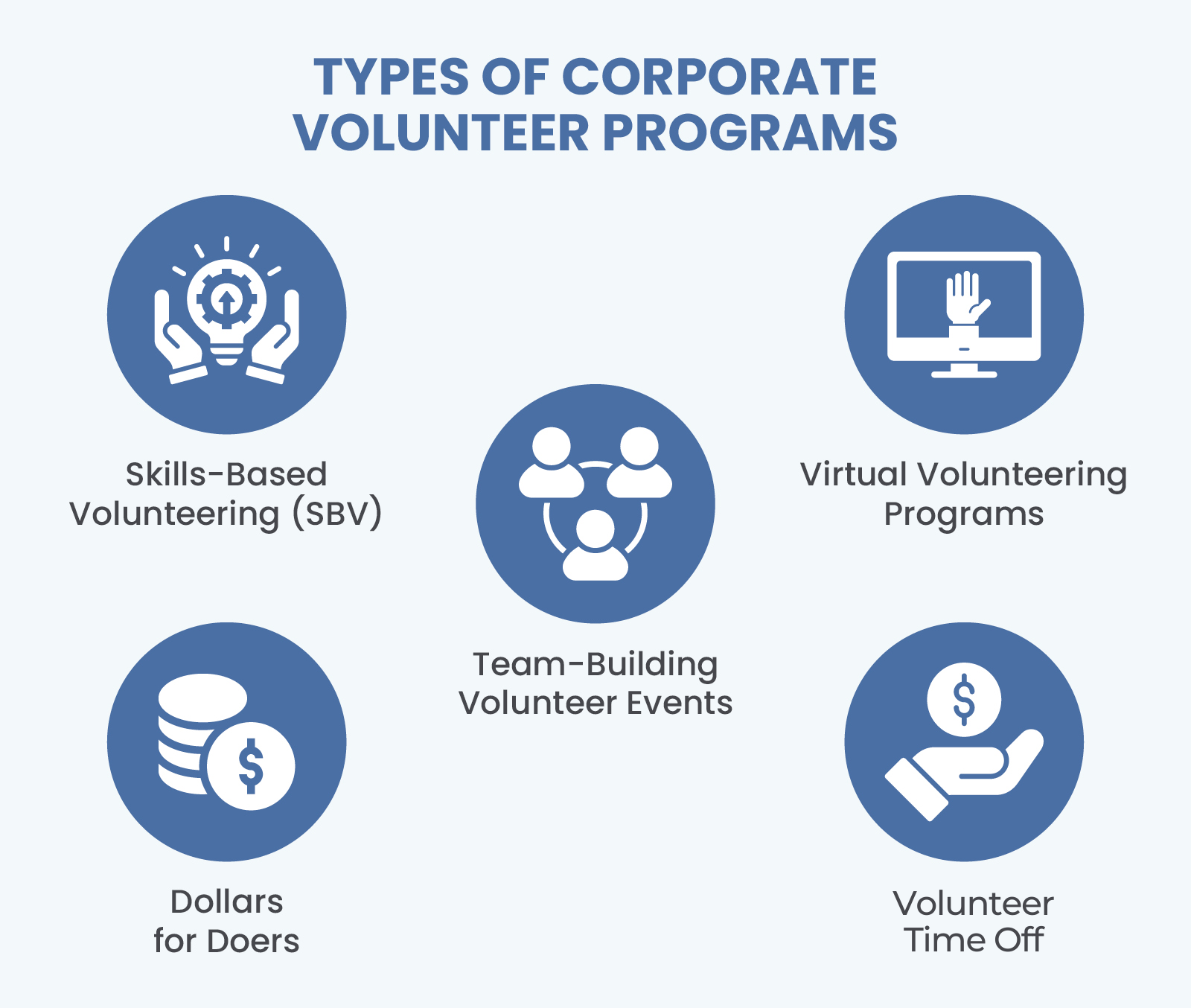How to Launch a Corporate Volunteer Program Employees Love
In today’s rapidly evolving business landscape, companies are increasingly recognizing the importance of corporate social responsibility (CSR) and the positive impact it can have on their employees, communities, and overall brand reputation. Among the various avenues for CSR engagement, establishing a corporate volunteer program has emerged as a powerful way for businesses to contribute meaningfully to society.
In this guide, we’ll cover everything you need to know about corporate volunteering, including:
- What Are Corporate Volunteer Programs?
- The Benefits of Corporate Volunteer Programs
- Types of Corporate Volunteer Programs
- 6 Tips for Launching a Corporate Volunteer Program
- Inspiring Examples of Existing Corporate Volunteer Programs
Whether you’re launching a new corporate volunteer program or enhancing your existing one, these insights will help you ensure it’s a success.
What Are Corporate Volunteer Programs?
Corporate volunteer programs, also known as employee volunteer programs (EVPs), encourage employees to engage in community service and volunteer activities during work hours or as part of the company’s broader corporate social responsibility efforts. These programs are designed to positively impact society while enhancing employee engagement, morale, and professional skills.
The Benefits of Corporate Volunteer Programs
Corporate volunteerism benefits the businesses that create the programs, the employees who participate, and the nonprofits that receive support. Explore the full list of benefits below:
For Businesses
Not only does volunteerism contribute to a more prosperous society, but it can also be a strategic investment for businesses, as it allows them to:
- Improve their brand reputation. Customers, investors, and partners often view socially responsible companies more favorably. As a result, businesses with corporate volunteer programs can strengthen their reputation.
- Network with other sectors. Collaborating with nonprofits through volunteer programs can lead to valuable partnerships and networking opportunities.
- Strengthen company culture. In a recent study, 82% of employees who volunteered with their companies felt more committed to their organizations. Corporate volunteer programs can help establish a culture of giving and increase employee satisfaction.
Although corporate volunteer programs require time and money, the benefits far outweigh the costs. Overall, you’ll have happier employees, customers, and other stakeholders who feel like your company supports worthwhile causes.
For Nonprofits
Nonprofits need all the extra help they can get. With limited budgets and resources, they’re often challenged to do more with less. That’s why charitable organizations rely on corporate volunteer programs to:
- Enhance their capabilities. Corporate volunteer programs provide nonprofits with a steady stream of volunteers. This influx of hands-on support can help nonprofits expand their outreach, deliver more services, and reach new audiences.
- Receive access to new skills and expertise. Corporate volunteers often bring specific professional skills and expertise to nonprofit projects, whether related to marketing, technology, finance, or project management skills. Nonprofits can tap into this specialized knowledge to improve their operations, develop effective strategies, and address complex challenges.
- Fund their missions. Some corporate volunteer programs offer financial support to nonprofits where their employees volunteer or contribute in other ways. These companies provide financial support either in the form of grants, donations, or matching gift programs. These financial resources can help nonprofits fund their initiatives, cover operational expenses, and invest in growth and sustainability.
To maximize these benefits, nonprofits should actively seek partnerships with businesses and explain how their support will contribute to the long-term success of their missions.
For Employees
Employees are the backbone of corporate volunteer programs, and they reap several benefits from getting involved, including:
- Improved well-being: Engaging in volunteer work can improve employees’ overall well-being by reducing stress, increasing happiness, and promoting a sense of fulfillment and purpose.
- Skill development: Employees often have the chance to develop new skills through volunteering, which can be valuable for both personal growth and career advancement. These experiences can enhance teamwork, leadership, problem-solving, and communication skills.
- Engagement: Volunteer programs provide opportunities for employees to connect with their communities, bond with coworkers, and experience the fulfillment that comes from helping others.
For the best results, empower employees to actively participate in your programs. Ensure that they feel comfortable advocating on behalf of the causes they’re passionate about and providing feedback on your philanthropic efforts.
Types of Corporate Volunteer Programs
Consider designing a program structure that accommodates various levels of involvement to cater to different employees’ schedules and nonprofits’ preferences. Here are a few common forms of corporate volunteering to create a multifaceted program:

Skills-Based Volunteering (SBV)
Around 25% of companies tie skills-based volunteering to an employee’s professional development plan, and 21% say they plan to make this connection in the future. These programs leverage employees’ professional skills to benefit nonprofits. For example, a marketing executive might help a nonprofit with its branding, while an IT professional might set up their computers.
Team-Building Volunteer Events
Group volunteer programs offer employees the chance to work together outside of their usual work environment. By collaborating on activities like community cleanups, food drives, and construction programs, employees can develop stronger bonds and enhance their communication and problem-solving skills.
Virtual Volunteering Programs
As remote work becomes more prevalent, virtual volunteer programs allow employees to contribute their skills and time online. This could involve online mentoring, content creation, or data analysis for nonprofits.
Dollars for Doers
In Dollars for Doers programs, a company provides monetary donations to eligible nonprofit organizations based on the number of volunteer hours an employee contributes. The company will set a predetermined monetary value per hour of volunteer service and donate the corresponding amount.
Volunteer Grants
Volunteer grants are similar to matching gifts. With this initiative, businesses provide financial support to nonprofits when an employee volunteers a certain number of hours. Unlike Dollars for Doers, volunteer grants are typically not based on a fixed dollar amount per hour but rather a lump-sum donation for reaching a specified volunteering threshold.
Volunteer Time Off
In this form of corporate volunteer program, employees are able to take time off work to participate in nonprofit volunteer activities. This way, volunteers can receive full compensation from their employers and support your organization at the same time. For example, Warner Media offers its staff up to 40 paid hours to spend volunteering each year!
6 Tips for Starting a Corporate Volunteer Program
Creating a corporate volunteer program requires more than a set-it-and-forget-it approach. It requires careful implementation, the right software, and ongoing management. If your business has decided to pursue corporate volunteering, use these tips to ensure your efforts are successful:
1. Define Your Goals and Objectives
Defining objectives for a corporate volunteer program requires a thoughtful and strategic approach. Firstly, work with your team to consider how volunteering can contribute to the company’s broader goals and societal impact. For example, if your company values environmental sustainability, your volunteer program might focus on tree planting or waste reduction campaigns.
Ensure that these goals are clear, measurable, and time-bound. Using the example above, the goal might be to organize and actively participate in a minimum of four tree-planting campaigns in collaboration with local environmental organizations, resulting in 500 planted trees by the end of the fiscal year.
Review and revise these objectives over time to ensure they remain relevant to your organization’s priorities and your community’s needs.
2. Build Partnerships with Nonprofits
A strong partnership between a nonprofit and your business can create a lasting impact on the communities you serve. Through a partnership, you’ll consistently provide support, whether via volunteerism or financial gifts, in exchange for public recognition from the nonprofit.
Here are three tips to help you establish and maintain such partnerships:
- Identify shared goals and values. Start by identifying shared goals and values between your business and the nonprofit. This alignment ensures the volunteer program will be meaningful and impactful for both parties.
- Establish clear expectations and roles. Define the expectations and roles of both your business and the nonprofit in the volunteer program, including the program’s scope, the number of volunteers needed, the engagement’s duration, and the tasks or projects involved. Establishing these specifics will avoid misunderstandings and ensure that both parties are on the same page.
- Provide resources and support. Understand the specific needs of the nonprofit and consider what else you can do to address them, whether through volunteer training, financial contributions, or in-kind donations. Demonstrating a deep commitment to their success will help you build trust and goodwill, strengthening the partnership over time.
Regularly assess the impact of your partnership, solicit feedback from both employees and the nonprofit, and be willing to adapt and grow the relationship as circumstances change.
3. Encourage Employee Engagement
Engaging employees in corporate volunteering is crucial for the success and impact of the program. Leverage these strategies to inspire their support:
- Communicate the purpose and benefits. Highlight how their participation can make a positive impact on the community, environment, or social causes. In addition, emphasize the personal and professional benefits of volunteering, such as skill development and team building.
- Align with employee interests. Seek input from employees to understand the causes they care about and tailor your volunteer opportunities accordingly.
- Offer Volunteer Time Off (VTO). Implement a VTO policy that allows employees to take paid time off specifically for volunteering activities. VTO provides employees with the flexibility and support to engage in volunteer work without sacrificing their regular work responsibilities. Ensure the VTO policy is clearly communicated and easily accessible to all employees.
You should also consider providing training related to volunteering activities. This can include workshops, webinars, or mentoring programs that enhance employees’ abilities to contribute effectively to the community.
4. Recognize Employee Participation
Recognizing participation in your corporate volunteer efforts can serve as a motivator for continued engagement. Common forms of recognition include:
- Public appreciation: Publicly extend your appreciation through company-wide announcements, newsletters, or internal communication platforms. Highlight specific contributions and express gratitude for their dedication.
- Certificates or awards: Present employees with certificates or awards when they reach certain milestones related to your corporate volunteer program. For instance, each month, you might host a contest to see who can volunteer the most hours, with the winner receiving the title “Volunteer of the Month.”
- Thank-you notes or emails: Send employees handwritten notes or emails detailing your gratitude. This individualized recognition demonstrates a personal touch and appreciation for their specific contributions.
- Team celebrations: Organize team celebrations or events to recognize employee participation in volunteer efforts. This can include team lunches, outings, or special recognition ceremonies where employees can share their experiences and celebrate their collective impact.
When employees feel recognized and appreciated for their work, they are more likely to feel inspired to participate in future activities. This can contribute to higher employee retention rates and a stronger sense of loyalty to your organization.
5. Make Volunteering Part of Larger CSR Efforts
Launching a corporate volunteer program is just the beginning of successful corporate social responsibility. There are several other activities that businesses can participate in to make a positive impact on society, including:
- Sponsorships: Support events, programs, or initiatives through financial contributions or in-kind donations. Sponsorships can range from supporting cultural events and sports activities to partnering with nonprofits for fundraising campaigns.
- Matching gift programs: Match employee donations to eligible nonprofits and boost employee participation through matching gift auto-submission. Made possible through integrations between 360MatchPro and certain CSR software providers, auto-submission allows you to double the impact of your contributions with the click of a button and a simple form of user verification.
- Environmental sustainability: Implement sustainable practices to reduce your carbon footprint, such as recycling, carpooling to work, or using renewable energy sources.
- Cause-related marketing: Collaborate with nonprofits to promote a cause or raise awareness through marketing. This can involve donating a portion of sales proceeds to a specific cause or partnering with nonprofits to create co-branded campaigns.
It’s important to note that the activities your business participates in will depend on your available time and resources. Conduct a comprehensive audit of your budget, schedule, and current CSR initiatives to determine how else you can lend your support.
6. Measure and Report on Impact
Measuring and reporting corporate volunteering data enables companies to make informed decisions about resource allocation, program expansion, and partnerships. To effectively measure and report on corporate volunteering, consider the following steps:
-
- Define key metrics. Identify the key metrics that align with your company’s goals and objectives. These may include volunteer hours, participation rates, skills gained, employee satisfaction, community impact, or other relevant indicators.
- Implement a tracking system. Use dedicated CSR software or a volunteer management tool to track and record volunteer activities, hours, and other relevant data. This will allow for accurate measurement and reporting of program impact.
Communicate your findings to key stakeholders through internal communication channels, social media, and annual reports. Tailor the messaging to different audiences and highlight the tangible outcomes that the program has had.
Inspiring Examples of Existing Corporate Volunteer Programs
Many companies around the world have established remarkable corporate volunteer programs that not only give back to the community but also boost employee engagement and company culture. Below are some inspiring examples of companies that have successfully integrated volunteerism into their corporate ethos—and use corporate volunteering software to do so.
Take a look and see which elements of the volunteer programs you can implement in your own efforts!

Bank of America
Bank of America fosters a culture of service by offering employees paid time off to volunteer and providing a matching gifts program that amplifies their charitable efforts. Employees can receive $500 in grants for every 50 hours volunteered at an eligible nonprofit, helping their contributions go even further.
In addition, the company organizes large-scale initiatives such as Neighborhood Builders, which provides leadership training and grants to nonprofit organizations.
Learn more about the corporate volunteer program here.

Patagonia
Patagonia is known for its deep commitment to sustainability. Through its Environmental Internship Program, employees can take up to two months of paid leave to work for an environmental nonprofit of their choice.
This particularly generous initiative aligns with Patagonia’s mission-driven approach to business and social responsibility. Plus, the company also offers a matching gift program!
Learn more about the corporate volunteer program here.

Walt Disney Company
Disney’s VoluntEARS program has been a cornerstone of the company’s corporate social responsibility efforts for over 40 years. Employees are encouraged to dedicate their time to causes they’re passionate about, whether it’s helping children in need, supporting environmental conservation, or working in disaster relief.
To further incentivize volunteerism, Disney awards EARS to You grants, which donate funds to nonprofits where employees have volunteered significant hours. The company also offers generous matching gifts to encourage financial support as well.
Learn more about the corporate volunteer program here.

Kohl’s
Kohl’s encourages employees to give back to their communities through its Kohl’s Volunteer Program, which provides grants to nonprofits where employees volunteer.
When a group of five or more associates volunteers at a nonprofit for at least three consecutive hours, the organization receives a monetary grant from Kohl’s. This initiative helps drive local community engagement while also rewarding employees’ dedication to social causes.
Learn more about the corporate volunteer program here.

Google’s volunteer program, Googler Serve, supports employees in finding opportunities to give back, whether through skills-based volunteering, nonprofit consulting, or hands-on community service.
Google also provides dollar-for-dollar donation matching for employees’ charitable contributions and volunteer time, ultimately maximizing their impact.
Learn more about the corporate volunteer program here.
A Final Note About Corporate Volunteer Programs
As we move towards a more socially conscious era, corporate volunteering will continue to play a vital role in the for-profit sector. To remain relevant and responsible, launch a comprehensive CSR program that includes employee volunteerism, matching gifts, sponsorships, and other initiatives. Your customers, employees, and benefitting nonprofits will definitely take notice!
For more information on corporate philanthropy, check out these additional resources:
- Employee Giving Guide: How to Empower & Engage Employees. Employees are at the center of your corporate volunteer program. Find new ways to inspire them to give back.
- 23+ Corporate Volunteer Ideas to Build A Better Community. As previously mentioned, corporate volunteerism can take many forms. Explore these innovative approaches.
- Top Corporate Giving Software to Drive Employee Engagement. Review a list of the top corporate giving software to drive employee engagement and create an organized giving process.




